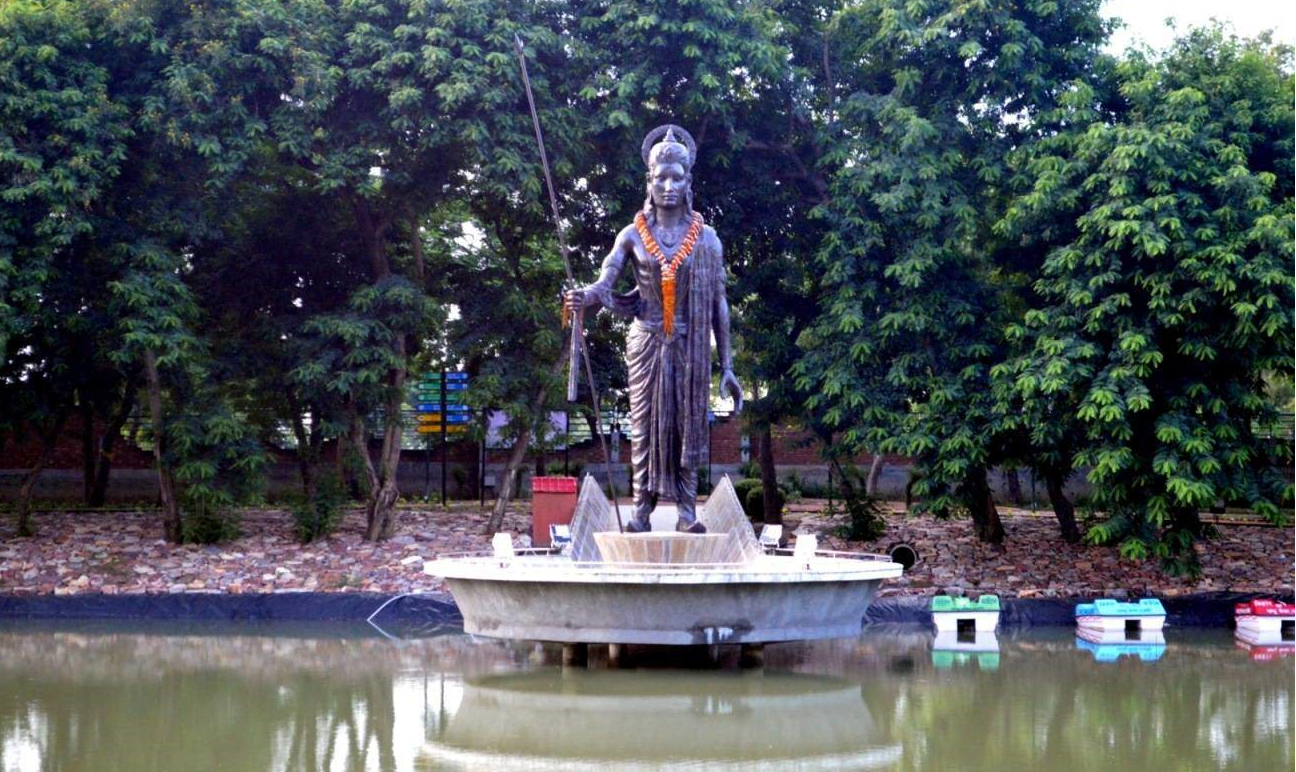
Nalanda Museum established in the year 1917 is one of the most prestigious site-museums of Archaeological Survey of India. It houses antiquities found from the excavated site of Nalanda Mahavihara supposedly the earliest university cum monastery complex which flourished during 5th – 12th centuries of Christian era under the patronage of Gupta, Maukhari and Pala rulers. Later on few object collected from the neighbouring villages of Nalanda and few from Rajgir too were added to the treasures of this museum. There about 350 artifacts at display whereas more than thirteen thousand are kept in the reserve collection. Display includes stone images and sculptures, bronzes, stuccos, terracottas, inscription, iron objects, ivory & bone objects and potteries etc. arranged in four galleries and the main hall.
The main hall exhibits master pieces of stone and two huge earthen storage jars. Twelve handed Bodhisattva Avalokitesvara, about two meters high image of Samantabhadra, Nagaraj with seven serpent hood canopy, a colossal image of Buddha seated in dharmachakra mudra, a tantric deity Trailokyavijya trampling Shiva-Gauri, and Buddha seated in bhumisparsa mudra are worth mentioning specimens in this hall. The central space of the hall has been occupied by a scale model of the excavated site in a table showcase.
"The Archaeological Site of Nalanda Mahavihara (Nalanda University) is included among the world heritage list of UNESCO (2016)."
Hiuen Tsang Memorial

Set up as a tribute to one of the greatest Buddhist scholars and travellers of the time, XuanZang travelled overland to India from China, through Taklamakan Desert and Himalayan mountains, in the seventh century without a map. The tremendous hardship he endured were rewarded by the 15 years of joy he enjoyed as a pilgrim in India. In his epic journal, he left behind a fascinating account of Indian culture, history, and society that he observed during his visits to the sacred sites, and while teaching and learning at Nalanda.
On his journey homewards, the legendary pilgrim carried with him 657 Buddhist texts, which later he translated into Chinese. These works helped clarify many of the misunderstandings of the Dhamma by ealy Chinese scholars, and also helped later researchers to discover many of the lost sacred sites connected to the Buddha’s life.
The complex’s large bell, donated by the Chinese government, contains an inscription of the Heart Sutra, the famous Mahayana text that articulates the empty and insubstantial nature of all existence. The memorial is about 2 km away beyond Nalanda ruins and its hall has beautiful murals that are stylistc replicas of Ajanta and represent of fusion of Chinese and Indian art
NAVA NALANDA MAHAVIHARA

In 1951, Bhikku Jagdish Kashyap, backed by India’s first President, Dr. Rajendra Prasad founded it with a hope to revive the ancient seat of Buddhist learning. The present campus is located on the bank of a peaceful lake, two kilometers from the ruins. The university offers diploma and degree courses in Pali, Philosophy and Indian culture.
RAJGIR(Girivraj)
Rajgir is a city and a noted area in Nalanda district in the Indian state of Bihar. The city of Rajgir (ancient Rājagṛha; Pali: Rājagaha) was the first capital of the kingdom of Magadha, a state that would eventually evolve into the Mauryan Empire. Its date of origin is unknown, although ceramics dating to about 1000 BC have been found in the city. This area is also notable in Jainism and Buddhism as one of the favorite places for Lord Mahavira and Gautama Buddha and the well known "Atanatiya" conference was held at Vulture's Peak mountain.
The name Rajgir came from Rājagaha 'house of the king' or "royal house", or the word rajgir might have its origin in its plain literal meaning, "royal mountain". It was the ancient capital city of the Magadha kings until the 5th century BC when Udayin(460-440 BC), son of Ajatshatru, moved the capital to Pataliputra. In those days, it was called Rajgrih, which translates as 'the home of Royalty'. Shishunaga founded Shishunaga dynasty in 413 BCE with Rajgir as its initial capital before it was moved to Pataliputra.
It is sacred to the memory of the founders of both the religions: Jainism and Buddhism and associated with both the historical Mahavira and Buddha.
Lord Mahavira, 24th Tirthankara spent fourteen years of his life at Rajgir and Nalanda, spending Chaturmas at a single place in Rajgir (Rajgruhi) and the rest in the places in the vicinity. It was the capital of one of his Shravaks(follower) King Shrenik. Thus Rajgir is a very important religious place for Jains.The twentieth Jain tirthankara, Munisuvrata is supposed to have been born here.An ancient temple(about 1200 years old) dedicated to Munisuvrat bhagwan is also present here along with many other jain temples.This temple is also a place for four Kalyanakas of Bhagwan Munisuvratnath.
Vishwa Shanti Stupa

Vishwa Shanti Stupa (World Peace Pagoda) is a popular Buddhist pilgrim site. It is situated on the Ratnagiri hill. It is a white beauty, showing the four phases of Buddha’s life through four golden statues of Lord Buddha. The Peace Pagoda is said to be built by a Japanese Buddhist monk, Nipponzan Myohoji in 1969. This stupa is world’s tallest Peace Pagoda and considered as the symbol of peace and harmony.
Jalmandir, Pawapuri
An important Jain pilgrimage, Jalmandir is situated in Pawapuri, Bihar. Jalmandir has been revered highly by Jain devotees as it is believed that it is the place where Lord Mahavira breathed his last in 500 BCE. It is reckoned to be the cremation ground for this last Tirthankara of Jain sect. The legend has it that, the demand of Lord Mahavira’s ashes was so high that a large amount of soil had to be eroded from around the funeral pyre that a pond was created here. A white marble temple was constructed and it has remained an important Jain pilgrimage in Bihar.
Bimbisara Jail

After Bimbisara handed over the kingdom over to his son Ajatsattu, the new heir became paranoid that his father may reclaim it. Overwhelmed by the fear, he had Bimbisara imprisoned without food, hoping the king would die. Bimbisara’s wife, Queen Vedehi was the only permitted visitor who kept her husband alive by smuggling food for him. When the king’s health did not deteriorate, the Queen was searched and all her smuggled food was confiscated. So she smeared paste of milk, honey, and floor all over her body for the king to lick off, but the plot was detected soon and she was debarred from meeting her husband altogether. Bimbisara still kept himself alive by his meditative powers, and would draw inspiration to see the Buddha walking up to the Vulture Peak to meditate. Getting impatient, Ajatsattu ordered his guards to slit his father veins. Bimbisara died without a hatred. The same day Ajatasattu’s wife bore him a son, Udayibhadda. Feeling great love for his son, Ajatasattu asked his mother whether his father also loved him so.
“No father could have loved his son more,” she said. “One time when you were a child, your father sucked on a boil that developed on your finger to help ease the pain. When the boil burst, he did not even take your finger out of his mouth to spit out the pus, fearing that its disgusting sight might frighten you. This is how deeply your father loved you.”
Ajatasattu realized his grave mistake and rushed to call off the orders to have his father killed, but it was too late. Ajatasattu was full of remorse, and was long haunted by fears of being murdered for the throne. His fears were realized many years later when he was killed by the hand of his own son.
Venu Vana

Venu Vana is the Bamboo Forest, gifted by the Magadha King Bimbisara to Lord Buddha about 2500 years ago and it is said to be one of Buddha’s favorite place during his stay there. There is a big pond in the midst of the Venu Vana. It is said that Lord Buddha used to take bath in this pond before starting his day in Rajgir. The pond escalates the beauty of the forest. The peace and serenity of the place is the main attraction for the tourists.
Vulture Peak (Gridhakut or Gijjhakta)

There are two ways to reach to the peak. The first option is to walk for 20 minutes beyond the stalls up the stairway, and then make a right at the fork in the path. According to XuanZang, the first cave on your right is said to be the where Ananda attained enlightenment before the First Council. The second cave on your right is said to be Boar’s Grotto, where Sariputta became an arahant. At the end of the main path you come across a stairway that leads to the top of the mountain containing ancient ruins and a contemporary shrine.
The Buddha shuttled between the Bamboo Grove and this crag, whose natural silence made it an ideal place for serious meditation. Many of the Buddha’s students, including Sariptta and Ananda, became arahants in one of the caves in this rocky hill. According to a fable, disturbed by a wicked vulture’s pecking the shaved head of the monks while they were meditating, the Buddha froze the vulture into a boulder and that’s how its called the Vulture Peak.
Saptaparni Cave

Saptparni Cave, also referred to as Saptaparni Cave or Sattapani Cave, is a Buddhist cave site about 2 kilometres (1.2 mi) southwest from Rajgir, Bihar, India. It is embedded in a hill. The Saptaparni Cave is important in the Buddhist tradition, because many believe it to be the site in which Buddha spent some time before his death, and where the first Buddhist council was held after Buddha died (paranirvana). It is here that a council of few hundred monks decided to appoint Ananda (Buddha's cousin) and Upali, believed to have a good memory and who had accompanied the Buddha when he gave sermons in north India, to compose Buddha's teachings for the future generations. The Buddha never wrote down his teachings. After the Saptaparni Caves meeting, Ananda created an oral tradition of Buddha's teaching from his memory, prefacing it with "Thus have I heard on one occasion". Upali is credited with reciting the Nikaya discipline or "rules for the Bhikshus".
Hot Spring (Rajgir)

At the foot of Vaibhava Hill, a staircase leads up to the various temples. Separate bathing places have been organized for men and women and the water comes through spouts from Saptdhara, the seven streams, believed to find their source behind the "Saptarni Caves", up in the hills. The hottest of the springs is the Brahmakund with a temperature of 45 degree Centigrade.
Ajatsatru Stupa

The pile of bricks, about one km from Venuvana, is said to be the stupa that Ajatsatru built to house his portion of the Buddha’s relics.
Rajgir Ropeway

Said to be the oldest ropeway in India, the Rajgir ropeway line is a wonderful excursion in the cradle of nature. It is the only ropeway in the state of Bihar. The single person seater rope line is a thrilling adventure that leads you all the way to the top of the scenic Ratnagiri Hill which houses the famous Vishwa Shanti Stupa, also known as the Peace Pagoda. The chairlift ropeway rises to a height of over 1000 feet from the ground level and is a thrilling ride to undertake. The area falls under the Pant Wildlife Sanctuary which provides unmatched views of the surrounding forest area. The ropeway gives access to the Buddhist memorabilia and constructions of a bygone era on the hilltop, coupled with picturesque views, there's nothing more you can ask for! Rajgir's location is set in a valley so that you can expect beautiful sightseeing views all around you. The place is richly associated with Buddhism and its practices, rituals and culture. Plans have been implemented to list the Rajgir ropeway as an important heritage site by the Bihar government under the suggestion of the Bihar State Tourism Development Corporation (BSTDC). It has been an important pilgrimage site for Buddhists, Hindus and Jains alike for centuries. There are several other landmarks on the hill top that possess great religious, historical and cultural significance. The important city of Rajgir has long been in historical records that date back thousands of years, finding its presence in age-old Mahabharata, Buddhist and Jain texts and the Rajgir ropeway is just another fantastic addition to your places to visit.
Rajgir Ropeway Attractions
The Rajgir ropeway offers fantastic views of the adjoining Pant Wildlife Sanctuary and the surrounding five hills namely Vipalachal, Vaibhagiri, Songiri and Udaygiri, other than the Ratnagiri hill that it is connected to. The attraction of the Peace Pagoda (a.k.a. Vishwa Shanti Stupa) on the hill top is a major cultural magnet attracting thousands of tourists and pilgrims during peak seasons. The gigantic stupa built in 1969 by the Japanese Buddhist order called Nipponzhan Myohoji serves as an earthly symbol of peace and harmony. There are a few other places of interest : Sugarakhata Caves - According to legends, it was here that Buddha had preached the Lotus Sutra and delivered sermons. Gridhkut Peak (Vulture's Peak) - One of the several sites frequented by Buddha and his disciples for training, retreat and delivering of sermons. Its location is frequently mentioned in ancient Buddhist texts. Buddha Temple - A small, quiet temple situated on the hilltop with amazing views of the surroundings. Ashoka Stupa - A brick construction quite a distance away from the pagoda known for its tranquil landscapes.
Jarasandh Ka Akhara

Magadh’s great majestic king Jarasandha’s capital was Grivarj which is known today by the name of Rajgir. According to the Mahabharta, this is where Bhima fought Jarasandha and Bhima rips apart Jarasandha’s body into two and threw in two opposite directions to prevent it from re-joining and hence successfully killing Jarasandha in the process.
Son Bhandar Caves

The Son Bhandar caves, also Sonebhandar, are two artificial caves belong to Jainism (to Ajivikas earlier) are located in Rajgir in the state of Bihar in India. The caves are generally dated to the 3rd or 4th century CE, based on the dedicatory inscription found in the largest cave which uses Gupta script of the 4th century CE, although some authors have suggested the caves could actually go back to the period of the Maurya empire from 319 to 180 BCE. The main cave is rectangular with a pointed ceiling, and the entrance is trapezoidal, reminiscent of the structure of the Barabar Caves (the first artificial caves of India, dated the 3rd century BCE). The quality of the "Mauryan polish" and the finish are nevertheless much inferior. The stone of Son Bhandar is also much less hard than the granite of the Barabar caves, and therefore did not require the same degree of effort and technique.
Tomb of Mallick Ibrahim Baya
Peer Pahari (At Bari Pahari). A beautiful ancient tomb constructed on top of the rocky hill. Nearby are the ruins, which are believed to be ruins of Jarasandh Jail. The beautiful natural view from the top of the hill is very attractive.
Cyclopean Wall of Rajgir

The Cyclopean Wall of Rajgir is a 40 km (25 mi) long wall of stone which encircled the entire ancient city Rajgriha (Present day Rajgir, in the Indian state of Bihar.) to protect from external enemies and invaders. It is among the oldest specimens of cyclopean masonry across the world.
It was erected by the rulers of Maurya dynasty before 3rd century BC using massive undressed stone for the protection of ancient city Rajgriha (present day Rajgir). It reminds the great administrative abilities of the Maurya Empires.
International Convention Centre at Rajgir

International Convention Centre is one of the first public buildings in Bihar to facilitate convention activities. The form of the Convention centre is inspired by form of the ‘Stupa’. The dome of the Convention hall is one of the largest domes in recent years with the clear span of 43.26 m. The casting of the dome on site was one of the most challenging and interesting feature of the project. Detailed stage drawings for cast in-situ of the dome were designed and prepared for the execution.
The project comprises of convention hall with 1300 capacity and a multipurpose amphitheatre with 900 capacities. Heritage museum, seminar and training complex which includes conference halls accommodating various capacities and other supporting facilities.
Ghorakatora Lake at Rajgir

This is a lake surrounded by beautiful hills. This is near WORLD PEACE PAGODA. As this area too is connected to the lord Buddha, govt. of Bihar has decided to mark this by largest statue of Buddha in India and among top 5 in the world.It's height will be 200 feet and it will take 3-4 yrs to get completed.
Pandu Pokhar (Rajgir)

Breathtaking landscapes and fun-filled activities makes PANDU POKHAR – a paradise for all. From beautiful gardens to an open air theatre, to a pond overlooking 37 feet tall bronze statue of King Pandu to a herbal maze – we are at a place to enjoy and admire nature. A park with a unique combination of entertainment and camping makes it a wonderful place for corporate events, school excursions, family and other social gatherings. Truly, a beautiful destination for a perfect vacation. Experience the goodness of nature with fun. Starting with adventurous Zipline and Zorbing, the park is filled with fun rides, games and pleasure gardens. At dusk, the display of colourful fountains in the pond enhances the beauty of the park. Evening walks in the serenity of the park allows nature’s peace to flow in, soothing the soul and mind.






